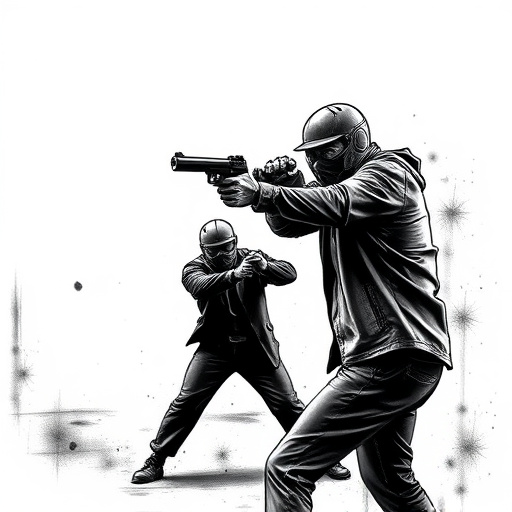Pepper spray, a popular self-defense tool, differs in effectiveness between indoor and outdoor use due to air circulation and environmental conditions. Indoor use requires precise application and testing in enclosed spaces, while outdoor use demands weather-resistant design and consideration of wind, temperature, and humidity. Legalities vary; understanding local regulations is crucial for responsible use. Choose aerosol-based indoor sprays with controlled nozzles and robust, adjustable outdoor sprays for optimal protection in distinct settings.
“In today’s diverse and often unpredictable world, citizens seek effective personal protection tools. Pepper spray, a versatile and widely used self-defense agent, offers crucial indoor and outdoor defense strategies. This comprehensive guide explores the intricacies of pepper spray use, focusing on its application in various settings: from bustling indoor spaces to open-air environments. We’ll navigate legal considerations, compare indoor vs. outdoor effectiveness, and provide expert tips for choosing the ideal spray, empowering individuals with knowledge for enhanced safety.”
- Understanding Pepper Spray: A Comprehensive Guide
- Indoor Use: Safety Measures and Best Practices
- Outdoor Protection: Effectiveness and Considerations
- Legal Aspects: Rights and Responsibilities of Citizens
- Choosing the Right Spray: Features to Look For
Understanding Pepper Spray: A Comprehensive Guide
Pepper spray, a powerful tool for self-defense, has become increasingly popular among civilians seeking protection both indoors and outdoors. Understanding its dynamics is crucial when considering its use. The primary active ingredient in pepper spray is capsaicin, the same compound that gives chili peppers their heat. When deployed, this chemical irritates the eyes, nose, and respiratory system, temporarily disabling an aggressor.
The distinction between indoor and outdoor usage is significant. In enclosed spaces like homes or offices (indoor use), pepper spray can quickly fill a room with its active ingredient, leading to severe discomfort and even incapacitation for those within. This makes it highly effective for close-quarters self-defense. Conversely, outdoor use requires careful consideration of wind direction and weather conditions, as these factors can impact the spray’s range and effectiveness. Proper training and understanding local laws regarding pepper spray possession and use are essential before considering it as a protection mechanism.
Indoor Use: Safety Measures and Best Practices
When considering pepper spray for indoor protection, it’s crucial to understand the unique safety measures and best practices distinct from outdoor use. Unlike open spaces where spray can dissipate quickly, enclosed areas like homes or offices present challenges due to poor air circulation. This is particularly relevant when discussing pepper spray indoor vs outdoor applications.
To ensure safety, always aim for targeted applications, focusing on the eyes and face of an aggressor. Keep in mind that wind or ventilation systems could potentially carry the spray back towards users. Regularly test the spray’s range and effectiveness in your specific indoor environment. Storage is also paramount; keep pepper spray out of reach of children and pets, stored in a cool, dry place away from heat sources to maintain its potency.
Outdoor Protection: Effectiveness and Considerations
When considering protective measures for outdoor activities, understanding the distinction between indoor and outdoor pepper spray is paramount. While indoor use primarily involves confined spaces where airflow is limited, outdoor protection demands a different approach due to varying environmental conditions. The effectiveness of pepper spray outdoors hinges on several factors, including wind speed and direction, temperature, and humidity levels.
In open-air settings, pepper spray’s active ingredients can disperse rapidly, potentially reducing their concentration at the target area. Strong winds can carry the spray away from intended victims, making it less effective. Conversely, humid conditions may cause the spray to evaporate faster, while colder temperatures can solidify its consistency. As such, selecting outdoor pepper spray designed for optimal performance in diverse weather conditions is crucial, ensuring its reliability when most needed.
Legal Aspects: Rights and Responsibilities of Citizens
When considering the use of inflammatory spray for civilian protection, it’s crucial to understand the legal aspects and rights that come with it. The legality of pepper spray varies significantly between indoor and outdoor settings. In general, citizens have the right to protect themselves, but responsibilities also come with this power.
Indoor spaces often have stricter regulations due to heightened safety concerns and potential for misuse. Possessing and using pepper spray inside homes or public buildings may be subject to local laws and restrictions. Conversely, outdoor use might offer more freedom, but it’s essential to understand the context: whether in a private property, a public gathering, or while facing potential threats from individuals or animals. Always stay informed about local regulations to ensure responsible and lawful protection.
Choosing the Right Spray: Features to Look For
When considering a pepper spray for civilian protection, it’s crucial to understand the difference between indoor and outdoor use. For indoor environments, like homes or offices, an aerosol-based spray is often recommended. These sprays typically have a shorter range but deliver a potent dose of capsaicin, the active ingredient causing the burning sensation. Look for features like a precise nozzle for targeted applications and a safety mechanism to prevent accidental discharge in close quarters.
In contrast, outdoor pepper sprays are designed for wider areas like streets or parks. They offer longer-range options with a higher concentration of capsaicin to deter potential threats. Key attributes to seek include a robust construction capable of enduring varying weather conditions, an adjustable spray pattern for both short and long distances, and a bright, easily visible design to startle assailants. Always consider the specific needs and constraints of your environment when making your choice between pepper spray indoor vs. outdoor models.
Pepper spray has established itself as a valuable tool for civilian protection both indoors and outdoors. Understanding its dynamics, safety measures, legal implications, and choosing the right product are key steps to maximizing its effectiveness. Whether deployed in enclosed spaces or open areas, proper usage of pepper spray can deter threats and ensure personal safety. When selecting a spray, look for features tailored to your environment—indoor vs. outdoor—to guarantee optimal performance when it matters most.
